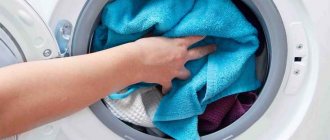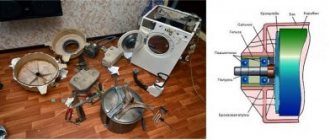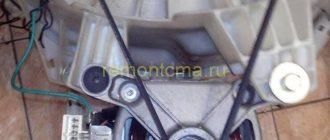Is your washing machine shaking and humming like a rocket about to take off? In this article we will talk about the main causes of noise and vibration during spinning. Let's look at how you can fix problems yourself and when you should still contact a specialist.
The connection manual is universal, suitable for all models with vertical and horizontal loading of the brands Ariston, Bosch, Candy, Gorenje, Indesit, Samsung, Siemens, Zanussi, Ariston, Bosch, Aeg, Beko, Electrolux, Haier and others.
Go!
Failure to comply with operating rules
The most common reason. The round shape of the drum helps to mix wet laundry into one pile. Manufacturers write in all instructions about the need to put small and medium-sized items into the machine along with large and bulky items to create balance. But it’s enough to leave one duvet cover unfastened for them all to become one big heap, which is difficult to turn around. To prevent such situations, you need to put the laundry folded for washing, making sure to fasten all the zippers and buttons.
Overload can also cause the washer to bounce and jump. In this case, stop the machine, drain the water and separate the laundry into parts. Always load laundry evenly, since the service life of the equipment depends on proper use.
Types of Vibrating Machines
There are certain rules by which their ability to vibrate can be determined. Do not forget that it is impossible to completely eliminate vibration. High revolutions, according to the laws of physics, provoke this phenomenon even in well-installed machines.
Narrow models of LG machines can shake and make noise the most. This happens because they have insufficient support area. Consequently, the car has poor stability, which leads to jumps. Also, the small machine is equipped with a narrow drum, so laundry often bunches up in it, thereby causing an imbalance in the drum.
Technical reasons
In addition to operational reasons, there are many other reasons why a machine knocks and moves (“dances”). Incorrect installation of equipment, failure of important parts and components. It can be difficult to fix such problems on your own. However, if they are diagnosed correctly, it is quite possible.
The floor is uneven or slippery
Uneven position of the legs is one of the common reasons that the machine rattles and bounces. To verify this, simply shake the machine. If it wobbles, determine which direction is more. And on this side, twist the leg, lifting it higher. This problem is common in homes with wood floors. Here you need to spend a lot of time to bring the machine into a perfectly level position.
Slippery floors are another possible cause. The washing machine simply rides on its rubberized legs on wet marble or tiles. Sometimes this happens on laminate flooring too. The solution may be to purchase special pads that will hold firmly even on the most slippery surfaces. Other options: an anti-slip silicone mat or moving it to another location.
Installation not level
If the machine is tilted to one side, the counterweight located inside the body, which holds it during operation, will be directed in that direction. This problem can be identified visually by examining the machine from a distance. If there is a building level, it will show exactly where the machine is tilted. To correct the situation, it is enough to place the equipment correctly.
Shipping bolts not removed
If the new machine hums, trembles and “walks”, the transport bolts may not have been removed. They are located on the back wall and are installed so that the drum remains in place during transportation. As a rule, there are four bolts. Unscrew with a regular screwdriver.
Don't throw them away: when moving, shipping bolts will help keep the mechanical insides of the machine intact.
Shock absorbers and dampers
Shock absorbers are cylinder-like parts with a rod, a piston and a “return” spring. Designed to dampen vibrations that appear at high speeds. Improved shock absorbers with an entire spring system are called “dampers”. Some modern car brands are equipped with them.
The service life of both is quite limited. They can fail if overloaded frequently. You can check the serviceability of the shock absorbers by removing the rear or front part of the car.
To begin with, try simply pressing on the tank. If it immediately snaps into place, then everything is fine with them. Otherwise, the tank will return with a slight delay.
All specified parts are paired. Therefore, if one shock absorber fails, both need to be replaced. Their cost is low, much cheaper than an additional call to a specialist. The same applies to dampers.
It's also worth checking the springs that support the tank. They are located on both sides and can stretch from prolonged use. They can also be replaced in pairs.
The engine runs rough
In addition to the stable and even noise of vibration or knocking, a completely different, sharp sound may occur, usually accompanied by a burning smell. This is a sign of engine failure. This happens due to its long service life, voltage surge or burnout of the armature winding.
If such sounds are produced by a recently purchased car, we are talking about a defective manufacturer. In this case, it is better to contact the service center while the warranty is valid (for washing machines, as a rule, for at least a year).
Objects stuck between drum and tank
Sometimes locks, brooches and other decorations fall out during washing. They fall into the holes of the drum and, periodically catching on it, make creaking sounds. To detect foreign objects, just look under the hatch cuff. If the object fell further, you will have to unscrew the heating element and other elements.
Bearings are worn out
The washing machine makes a characteristic noise and rumbles: the bearings may have failed. Rotate the drum by hand. Inhomogeneous rotation, sometimes quite difficult, indicates that it is time to replace this consumable.
If this is not done in a timely manner, excessive load will appear on the shaft and drum, which will lead to more expensive repairs in the future. Bearings are considered consumable items, requiring replacement every 3-5 years. Fortunately they are inexpensive. If you wish, you can replace them yourself.
The belt has dried out
If the drum spins too easily and produces an unpleasant scraping sound, there may be a problem with the direct drive. The drive belt serves to connect the drum and the engine. Infrequent use of the washing machine or prolonged work on worn out bearings leads to weakening of the tension. How to accurately determine that the problem is in the belt and what to do about it can be read here.
Damaged shaft
In addition to strong vibration and “jumping,” damage to the shaft may be indicated by rusty stains at the bottom of the washing machine. This is a serious breakdown. You won’t be able to fix it yourself without the proper experience.
Fastenings of internal elements are loose
Another reason why the washing machine “walks” and even “dances” on the surface may be insufficient fastening of the internal elements. If this is not corrected in a timely manner, several main components will fail at once. Therefore, you should check how well the crosspiece, counterweight and fasteners supporting the tank are tightened. If necessary, secure more firmly.
What do experts advise when your washing machine jumps?
- Use the included noise-insulating rubber or silicone pads for the legs;
- When installing, lay an additional soundproofing layer behind the wall of the machine;
- Built-in models require additional space to prevent the headset from loosening;
- Load the equipment so that it is 1/3 free;
- Remove shipping bolts before installation and connection;
- Use a magnet or vacuum cleaner to remove small objects;
- Sort items by size and fabric type before storing;
- It is better to entrust the replacement of the engine, bearings, and springs to a specialist.
Watch a video about what to do if the washing machine jumps during the spin cycle
Tips and tricks
In most cases, you can remove the vibration of the washing machine during the spin cycle yourself. To do this, it is enough to evaluate how level it is using a level. If you don’t have one, use a bottle half filled with water, on which draw a straight vertical line in the center. After this, place the container on the washer and see how much the water level deviates from the horizon.
To prevent the washing machine from jumping and humming here and now, you can use the following items:
- Place cardboard and thick paper under the legs on the swinging side.
- If the floor is too slippery, use a cotton rag - it will increase resistance and allow you to complete the wash cycle.
- In the future, it is better to buy an anti-vibration and anti-slip mat.
Nuances of troubleshooting
If the washing machine often jumps during a quick spin cycle, then experts will tell you what to do with it. Independently allowed:
- Remove transportation fasteners based on the manufacturer's instructions;
- Adjust the legs in height and install equipment according to the level;
- Install anti-vibration devices - mats and stands;
- Determine bearing failures by turning or rocking the drum;
- Repair the upper, front or rear counterweight by removing the upper housing;
- Tighten the fastenings of parts if they become loose.
Important! If you are not confident in your abilities and knowledge, entrust the repair to specialists.
How to connect the washing machine correctly
To ensure trouble-free operation of the washing machine, it is necessary to install it correctly, choosing the optimal location. Before first use, be sure to read the instructions in order to operate the device safely. The rules for connecting equipment consist of the following steps:
- choosing a place where the washing machine will be located;
- preparation for operation;
- connection to water supply;
- sewer connection;
- connection to the electrical network;
- installation of equipment.
First of all, you need to choose a location for the device. If the bathroom is small, then the machine can be placed in the kitchen or bathroom. The main thing is that the floor in this place is level, so that it is possible to connect sewer and water pipes, as well as connect the device to electricity. As for the bathroom, excessive humidity can negatively affect the parts, thereby shortening the service life of the equipment. Using the machine in the bathroom is not very convenient, considering that washing can last for hours. If the washing machine is placed in the kitchen, the beautiful appearance of the shiny front panel may be ruined by splashes and stains.
The device preparation stage includes the removal of packaging materials and other shipping parts, such as staples and bars
Important: Do not turn on the washing machine before you have removed the transport bolts, as this may cause it to malfunction. If the kit contains plastic plugs, they should be installed in place of the bolts
It is important to understand that connecting equipment to the water supply is a responsible matter, since improper implementation of this item can lead to water leakage. Usually a water hose and the necessary fittings are supplied, but its length may not be sufficient to connect to the pipe in the required place
There are two ways to solve this problem: purchase a longer hose or connect the pipe directly to the machine. If you decide to go the first route, then when buying a part, you should take the length with a margin so that the tube does not get stretched, much less twist, stopping the water supply.
Connecting a washing machine to the sewer is possible in two ways: fixing the pipe to the drain of the bathtub or washbasin, or connecting the pipe to the sewer pipe. The first option does not provide reliability, since the hose may be accidentally touched and water will spill onto the floor. It is optimal to connect the device permanently, in which case the reliability of the connections will be guaranteed. When connecting household appliances at this stage, it is necessary to take into account the length of the drain hose and the presence of a special siphon, which will prevent sewage and unpleasant odors from entering the device.
When connecting the device to the mains, please note that the machine consumes quite a lot of energy. Therefore, this procedure must be carried out carefully, taking into account the fact that the machine is in contact with water and current. To ensure safe operation, it is recommended not to use extension cords, but to supply electricity using special plastic boxes. The use of sockets with the appropriate degree of electrical safety is considered the best option.
After you have connected all the required hoses and removed the shipping bolts, you need to level the washing machine using the adjustable feet. It is recommended to place the device on a concrete surface to ensure a stable position. Do not place various objects under the legs in an attempt to level the equipment.
Remember that vibration during the spin cycle may indicate serious problems with the device.
Bearing problem
Malfunctions associated with bearing failure are far from a rare occurrence. The main reasons for the failure of this part are due to the fact that the metal from which the elements are made breaks down over time due to exposure to water. When the bearings begin to deteriorate, the operation of the device will first be accompanied by increased vibration and noise, and then the drum may completely jam.
When a bearing just begins to fail, it is quite difficult to identify problems. Typically, professionals can tell when a part is worn by sound, but this requires experience and knowledge. But when the bearing is already badly damaged, you can move the drum. When it moves in different directions, it means it's time to call a technician to replace the worn bearing.
What can we talk about in the end? It turns out that a washing machine is a complex system that needs professional help to resolve technical problems and it is worth contacting qualified specialists with experience and knowledge to quickly and effectively fix the problem.
See also:
- 15 best washing machines from 30,000 to 40,000 rubles according to customer reviews
- 5 Best Whirlpool Washing Machines Based on Customer Reviews
- 6 best Bosch washing machines according to customer reviews
- 7 best Indesit washing machines according to customer reviews
- 7 best LG washing machines
Shock absorbers are faulty
It is necessary to inspect the shock absorbers, which serve to soften shocks when the drum moves, reduce loads and dampen vibrations. If the device vibrates or jumps a lot, the shock absorbers may need to be replaced. Shock absorbers are mounted together with spring mechanisms, but if only the shock absorbers are worn out, they can be replaced separately; if the springs are also faulty, then all of them will have to be replaced at once. Over time, shock absorbers wear out and cannot be repaired - replaced immediately. Wear may be uneven, but if only one is faulty, both shock absorbers must be replaced to ensure balanced load distribution.
Look to see if there are small things stuck under the drum.
If they are, you will have to get them. For example, a bra wire or a paper clip can be easily taken out; if you pick it up with something, you can make something like a hook, which will be convenient for pulling out small parts. If smaller parts are stuck and you cannot get them out, you will have to disassemble the washing machine. To do this, you need to remove the heating element, drum and some other parts. If you have never disassembled washing machines, then it is better to call a specialist who will do it as quickly as possible, which will save you a lot of time, but most importantly, it will be safe for the equipment. See also:
A bra wire got into the washing machine
Transport bolts
If you install the washing machine yourself and have never had to do this before, then you can leave the so-called transportation bolts. Which are required to be installed at the factory so that the tank itself with counterweights does not move during transportation.
If you don’t remove them, the machine will wash them! But its balancing is disrupted (since these bolts often hold counterweights) and when spinning, a rumble occurs.
The easiest reason is to simply remove (unscrew) these bolts, usually there are four, rarely six on the back. Performance should be restored











